How to Find Housing
Getting settled in a new city can sometimes seem overwhelming…but we’ve got you covered with all the ways you could finding housing in Dublin – from renting, to room sharing, to purchasing a home. And we’ve included information you’ll need for securing your utilities as well (and we know you can’t live without internet, so we’ve added that in too!)
1. What areas should I look into?
Dublin is divided by Postal Districts. You can quickly navigate your way by remembering odd numbers are the North Side of the River Liffey and even numbers are on the South Side of the Liffey. Luckily for us, TTEC has two locations – one each side of the river! Both locations are really well connected via public transport links. Check out the Postal Districts on the Map below.
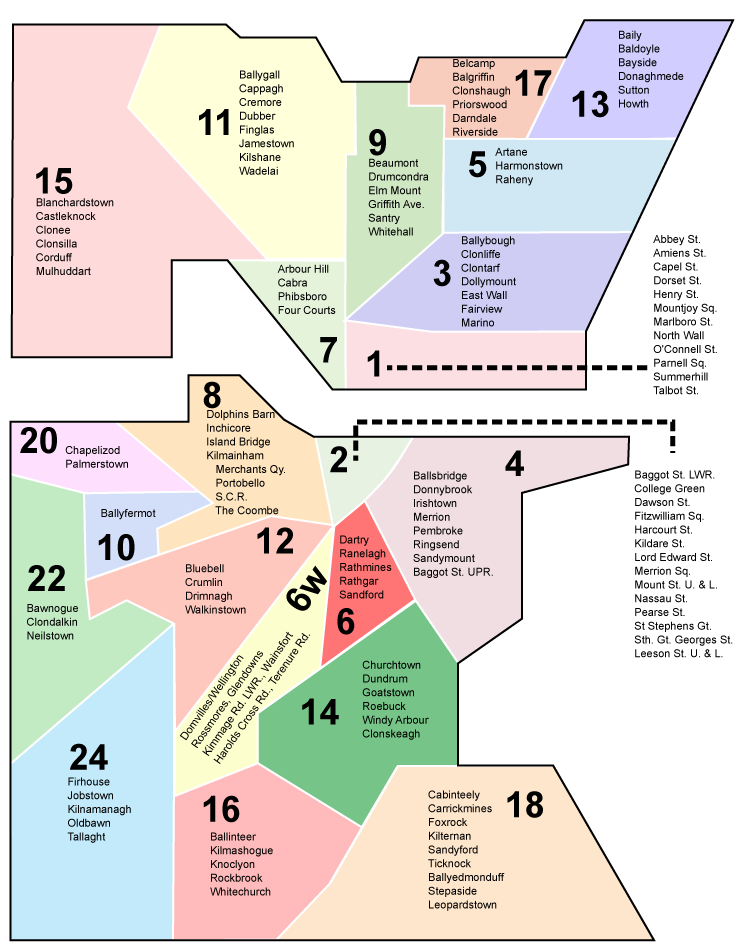
Eastpoint Office Address:
Pinnacle 1 Block 8
Eastpoint Business Park
Alfie Byrne Road
Dublin 3
Sandyford Office Address:
The Chase
Carmanhall Road
Dun Laoghaire – Rathdown
Dublin 18
When choosing where to live, there are a few factors we all need to consider. Price and location are always important. To help with the location and more information on each of the residential areas around Dublin, we’ve put together a list below based on the value for your pocket, and the distance from our NorthSide and SouthSide locations.
Keys:
€ = Value for Money
⬆ = Distance from EastPoint Office (North Side)
⬇ = Distance from Sandyford Office (South Side)
Dublin 1. €€€. ⬆.5 – 3km // ⬇ 9-10km
Dublin 1 is north inner city and is separated from Dublin 2 by the River Liffey. For a full neighbourhood overview and residential statistics of the area visit MyHome’s Neighbourhood Guide Dublin 1
Dublin 2 €€€€. ⬆ 1.5 – 4.5km // ⬇ 8-10km
Dublin 2 is part of Dublin city centre on the opposite side of the River Liffey to Dublin 1. For a full neighbourhood overview and residential statistics of the area visit MyHome’s Neighbourhood Guide Dublin 2
Dublin 3 €€€€. ⬆.5-2.5km // ⬇ 11 – 13.5km
Dublin 3 is in northeast Dublin bordering Dublin 1 and only a few kilometres from Dublin city centre. For a full neighbourhood overview and residential statistics of the area visit MyHome’s Neighbourhood Guide Dublin 3
Dublin 4 €€€€€. ⬆2.5 – 8km // ⬇ 5 – 7.5km
Dublin 4 is to the southeast of Dublin city centre. Bordering Dublin 2 it is just a few minutes taxi or DART ride away from the city centre. For a full neighbourhood overview and residential statistics of the area visit MyHome’s Neighbourhood Guide Dublin 4
Dublin 5: €€€. ⬆4 – 8km // ⬇14.5 -17.5km
Dublin 5 is in north east of Dublin city bordering Dublin 3. For a full neighbourhood overview and residential statistics of the area visit MyHome’s Neighbourhood Guide Dublin 5
Dublin 6: €€€€ ⬆7 – 9km // ⬇ 5.5-7.5km
Dublin 6 is in Dublin south to the west of Dublin 2 and Dublin 8. For a full neighbourhood overview and residential statistics of the area visit MyHome’s Neighbourhood Guide Dublin 6
Dublin 6W: €€€ ⬆6 – 10km // ⬇8.5-10km
Dublin 6W is a postal district in Dublin. Dublin 6W includes Harold’s Cross, Kimmage, Templeogue and Terenure. For a full neighbourhood overview and residential statistics of the area visit MyHome’s Neighbourhood Guide Dublin 6W
Dublin 7: €€€ ⬆ 3.6 – 8km // ⬇9.5-11km
Dublin 7 is Northwest of Dublin city centre. For a full neighbourhood overview and residential statistics of the area visit MyHome’s Neighbourhood Guide Dublin 7
Dublin 8: €€€€ ⬆ 4 – 8km // ⬇9.5-12.5km
Dublin 8 is to the west of Dublin 2 and includes the areas of Dolphin’s Barn, Inchicore, Island Bridge, Kilmainham, Merchants Quay, Portobello, South Circular Road and the Coombe. For a full neighbourhood overview and residential statistics of the area visit MyHome’s Neighbourhood Guide Dublin 08
Dublin 9: €€€ ⬆ 2.9 – 8km // ⬇14-16km
Dublin 9 is north of Dublin city beside Dublin 1 and Dublin 7. For a full neighbourhood overview and residential statistics of the area visit MyHome’s Neighbourhood Guide Dublin 09
Dublin 10: €€ ⬆ 9 – 11km // ⬇13-14km
Dublin 10 is in Dublin south and includes the area Ballyfermot which is known mainly for its industrial parks. For a full neighbourhood overview and residential statistics of the area visit MyHome’s Neighbourhood Guide Dublin 10
Dublin 11: €€ ⬆ 4 – 8km // ⬇ 13.5 – 15.5km
Dublin 11 is in northwest Dublin which borders Dublin 9. Dublin 11 includes the areas of Santry and Ballymun. For a full neighbourhood overview and residential statistics of the area visit MyHome’s Neighbourhood Guide Dublin 11
Dublin 12: €€€ ⬆ 7.5 – 11.5km // ⬇10 – 12km
Dublin 12 is located in Dublin south and includes the areas of Bluebell, Crumlin, Drimnagh and Walkinstown. For a full neighbourhood overview and residential statistics of the area visit MyHome’s Neighbourhood Guide Dublin 12
Dublin 13: €€€ ⬆ 10 – 15km // ⬇ 19 – 25km
Dublin 13 is in north Dublin and encompasses the areas Ayrfield, Baldoyle, Balgriffin, Bayside, Clongriffin, Donaghmede and Sutton. For a full neighbourhood overview and residential statistics of the area visit MyHome’s Neighbourhood Guide Dublin 13
Dublin 14: €€€€ ⬆ 8 – 14km // ⬇3 – 6.5km
Dublin 14 is at the foot of the Dublin mountains. For a full neighbourhood overview and residential statistics of the area visit MyHome’s Neighbourhood Guide Dublin 14
Dublin 15: €€€ ⬆ 6.5 – 15 km // ⬇ 14 – 21km
Dublin 15 is to the west of Dublin city and borders Phoenix Park, one of the world’s largest city parks which is home to Dublin Zoo and the President of Ireland. For a full neighbourhood overview and residential statistics of the area visit MyHome’s Neighbourhood Guide Dublin 15
Dublin 16: €€€€ ⬆ 9.5 – 15km // ⬇3.5 – 8km
Dublin 16 is in Dublin south on the foothills of the Dublin mountains. For a full neighbourhood overview and residential statistics of the area visit MyHome’s Neighbourhood Guide Dublin 16
Dublin 17: €€ ⬆ 4.5 – 8km // ⬇ 15 -18.5km
Dublin 17 is in north Dublin and encompasses the areas of Belcamp, Clarehall, Coolock Balgriffin, Clonshaugh, Priorswood, Darndale and Riverside. For a full neighbourhood overview and residential statistics of the area visit MyHome’s Neighbourhood Guide Dublin 17
Dublin 18: €€€€ 4.5 – 8km // ⬇.5 – 5km
Dublin 18 is in south Dublin and is home to one of Dublin’s fastest growing business and industrial areas. For a full neighbourhood overview and residential statistics of the area visit MyHome’s Neighbourhood Guide Dublin 18
Dublin 20: €€ ⬆9 – 12km // ⬇13 – 16km
Dublin 20 is in southwest Dublin. For a full neighbourhood overview and residential statistics of the area visit MyHome’s Neighbourhood Guide Dublin 20
Dublin 22: €€ ⬆ 12.5 – 15km // ⬇16-17.5km
Dublin 22 is to the west of Dublin and runs into County Kildare. For a full neighbourhood overview and residential statistics of the area visit MyHome’s Neighbourhood Guide Dublin 22
Dublin 24: €€ ⬆ 14 – 18km // ⬇12.5 – 15km
Dublin 24 is one of the biggest suburban areas in Dublin. It is mostly made up of Tallaght and borders the Dublin/Wicklow Mountains. For a full neighbourhood overview and residential statistics of the area visit MyHome’s Neighbourhood Guide Dublin 24
2. How to Find a House
Now that we know the areas around the city and the distance between our preferred location and our offices, it’s time to start looking for the right type of property for you. In Ireland, particularly in Dublin, you will need to have some documents prepared to stay ahead of the game!
Documents to have ready before your house search:
• A Previous Landlord Reference (explaining the period you lived there and confirming bills and expenses were paid in full and on time)
• A reference letter from TTEC to outline that you are employed here and outlines the commencement date of your contract
• A copy of a government recognized form of Identification (typically you can just take a picture of your passport or driver’s license)
** Sometimes you may be required to provide bank statements or pay slips from work as a way to show your stable employment **
3. Renting Your Own Property
Rental - Full Property From Lease Day 01
Renting houses in Ireland is always done through an estate agency or private landlord. This is a good way to get a house if there is a group of people who wish to live together, a family or a group of friends. This is also ideal for those looking for a studio or smaller apartment for, maximum 2 people.
Why not see if any of your new colleagues want to look for a house together?
Online Property Websites
• Daft.ie is Ireland’s No.1 Property Site
• Myhome.ie
• Rent.ie
• Property.ie
Work with an Estate Agency - here’s a list of the best:
Sherry Fitzgerald
You can search for your preferred property type, number of rooms, price and more! Alternatively, chat with an agent to get assistance on your search.
• Savills Estate Agency
• Hooke and McDonald
• McNally Handy
*Note: will likely find these properties listed on daft.ie as many Estate Agencies use this function, you can check the agency on daft, see screenshot below:
Next Steps:
Once contact is made, a viewing of the property is the next step! Many agencies have the option of facilitating a virtual viewing – see Sherry Fitzgerald’s option to Virtually View a property of interest
If you are happy with the property, next step is to complete an application form. Along with this application form, you send in your prepared documents (previous landlord reference, work reference, copy of ID).
Once this is finished, the agency or landlord will confirm your ability to move in on your agreed date.
When you move into a property of this type in Dublin (ie, rental), you will be required to pay your first month’s rent and deposit (usually equal to a month’s rent) prior to your move-in date. When renting the property, this is the rent for the house, not just a room.
If you’re unsure of your rights in a property, always consult the Residential Tenancies Board Website
4. Renting in a Shared House
Now that we know the areas around the city and the distance between our preferred location and our offices, it’s time to starch looking for the right type of property for you.
Documents to Have Ready before your House Search:
• A previous landlord reference (explaining the period you lived there and confirming bills and expenses were paid in full and on time)
• A reference letter from your company to outline that you are employed there and outlines the commencement date of your contract
• A copy of a government recognized form of Identification (typically you can just take a picture of your passport or driver’s license)
** Sometimes you may be required to provide bank statements or pay slips from work as a way to show your stable employment **
Rental - House Share
A lot of people choose to house share when they move to Dublin. It’s a great way of meeting new people and keeping costs under control. Typically this is when you move into a rented property with others, where you have a room of your own but share common living spaces such as the kitchen, living room and bathroom.
Why not see if any of your new colleagues want to House Share? If not, there are a number of places to seek out this type of accommodation:
Facebook Groups
Some of these groups ask you to complete some information on why you want to join the group, these tend to be more reliable in terms of content, less spam and more interaction from group members. Here are some suggestions:
- Rent in Dublin is a Facebook page by HouseHunt.ie – it’s a public page so it will give you a peek into what these groups work like
- The Ideal Flatmate Dublin – They’ve got >70,000 members – you’re bound to find your Ideal Flat and Flatmate!
- Dublin Rent a Room/House/Apartment/Flat/Accommodation – With a Security form and >50,000 members, this is another great page to start signing up to!
Online Property Websites
These websites are more common for renters looking to rent a house as opposed to a room, however, on daft.ie – Ireland’s leading property website, you can actually look for a House Share Room, see the screengrab below to see how!
How to Navigate Daft.ie for House Shares
1. Go to daft.ie
2. Search for Shared Rooms
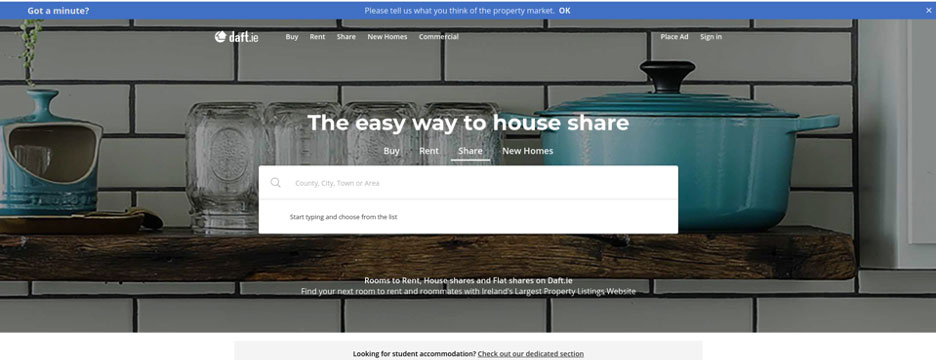
3. Add your preferred location, Dublin 3, for example
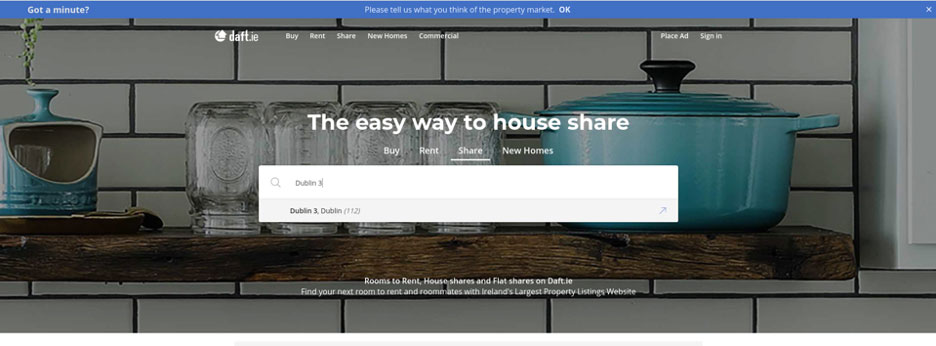
4. Detail the filters by adding further preference like Price and Room Type
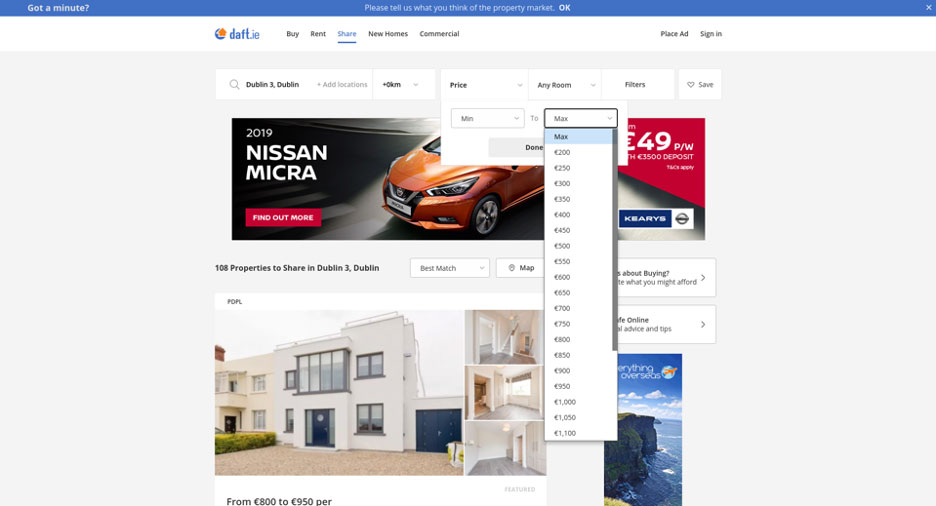
5.You can search similar properties via List View
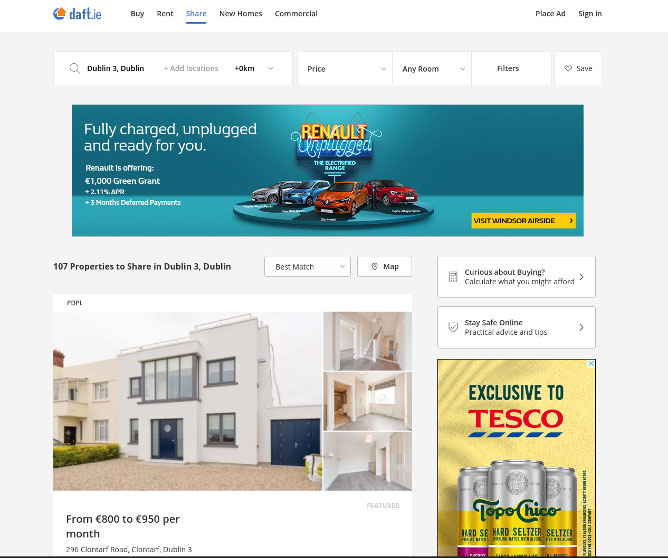
6. You can search similar properties via Map View
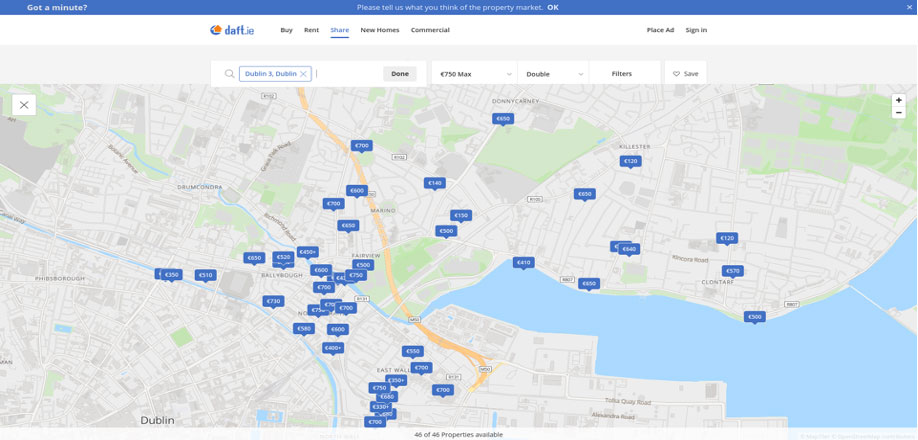
7. Just hover the mouse over the prices, click the property to find out more!
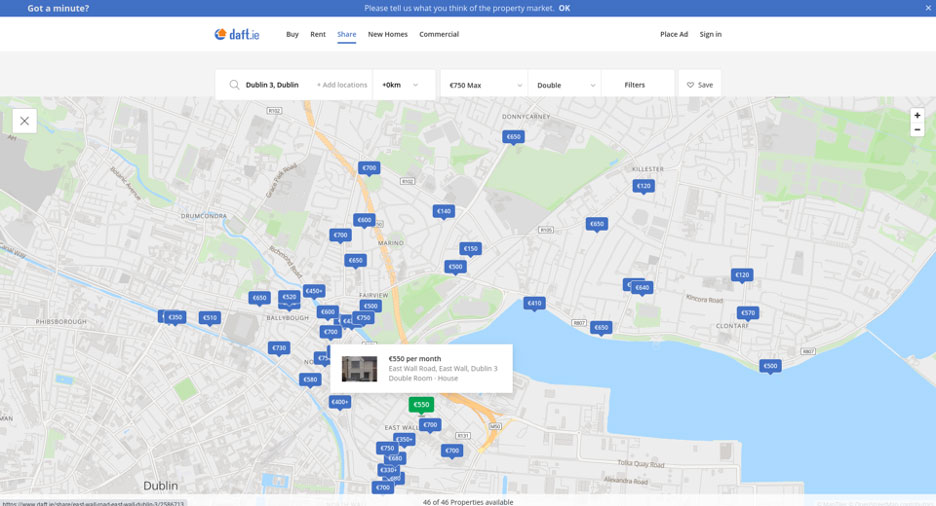
8. Follow the link to the property to arrive to the property page:
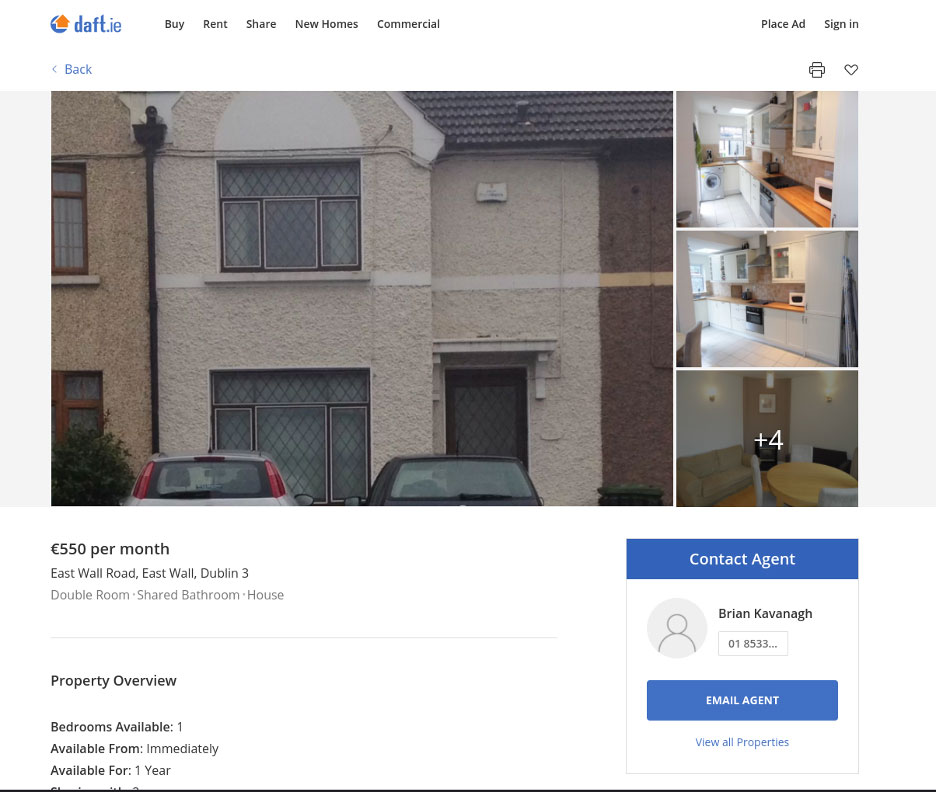
9. On that page you can contact the agent (may be from an estate agency, or a private landlord).
Next Steps:
Once contact is made, a viewing of the property is the next step! Many agencies have the option of facilitating a Virtual Viewing – see Sherry Fitzgearld’s option to Virtually View a property of interest
If you are happy with the property, next step is to complete an application form. Along with this application form, you send in your prepared documents (previous landlord reference, work reference, copy of ID).
Once this is finished, the agency or landlord will confirm your ability to move in on your agreed date.
When you move into a property of this type in Dublin (ie, rental), you will be required to pay your first month’s rent and deposit (usually equal to a month’s rent) prior to your move-in date. When renting the property, this is the rent for the house, not just a room.
If you’re unsure of your rights in a property, always consult the Residential Tenancies Board Website
5. Buying Property in Ireland
Buying a home in Ireland
If you are looking to set up your permanent home in Ireland, there are a number of things to consider. The first thing to do is decide on your budget, if you’re not sure on what you can afford, you can use this Budget Planner. Once you know your budget and the location you want to buy in, it’s time to start your hunt!
The Citizens Information Website should be your first step in understanding the steps involved in buying a home.
Basic Steps towards Buying a Home in Ireland:
• Save and define your budget ( Check House price statistics via Gov.ie )
• Research and apply for a mortgage (use this Shopping Around Checklist to get the best mortgage offer for you!)
• Find a Solicitor
• Start your Search – online websites and real estate agencies – see below
• Make an offer
• Close the deal and finish paperwork
Follow this Step by Step Guide on Buying a Home in Ireland.
Now we understand how to approach our house search, by knowing the area and our budget, we are ready to start searching. Much like renting, Daft.ie is the best place to start your search to get a general overview of prices and expectations in each area.
Online Property Websites
• Daft.ie is Ireland’s No.1 Property Site
• Myhome.ie
• Rent.ie
• Property.ie
Using Daft.ie to Start your House Hunt
1. Go to daft.ie/
2. Search for Buy

3. Add your preferred location, Dublin 3, for example

4. Detail the filters by adding further preference like Price // No. of Rooms
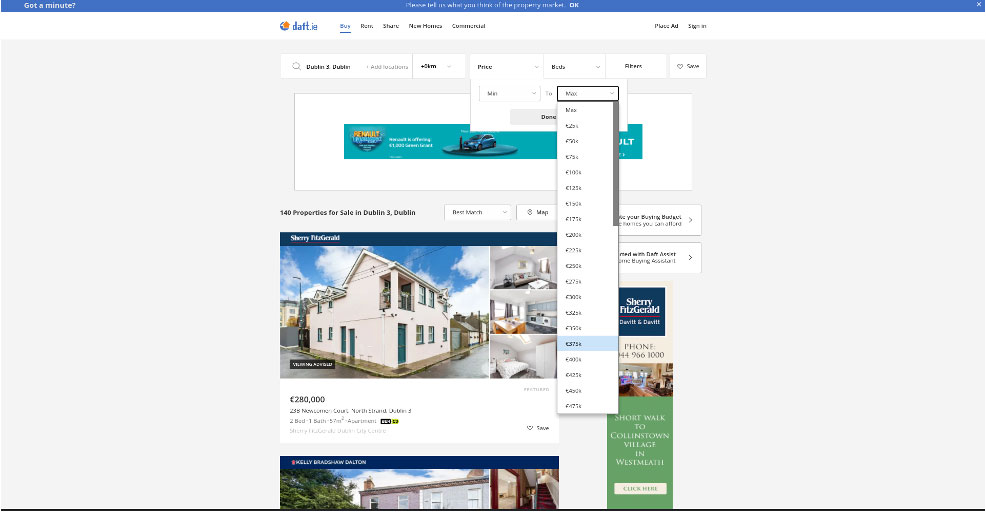
5. You can search similar properties via List View as Above
6. Or you can search similar properties via Map View
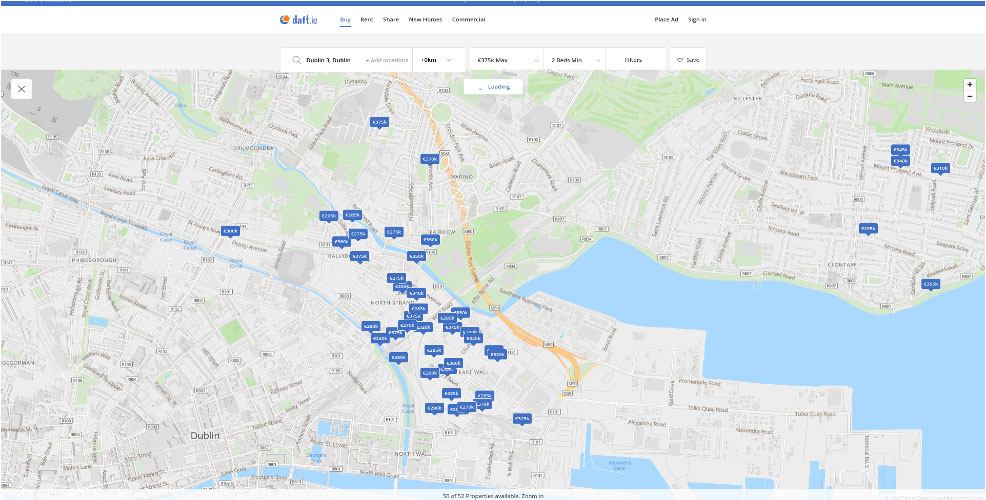
7. Just hover the mouse over the prices, click the property to find out more!
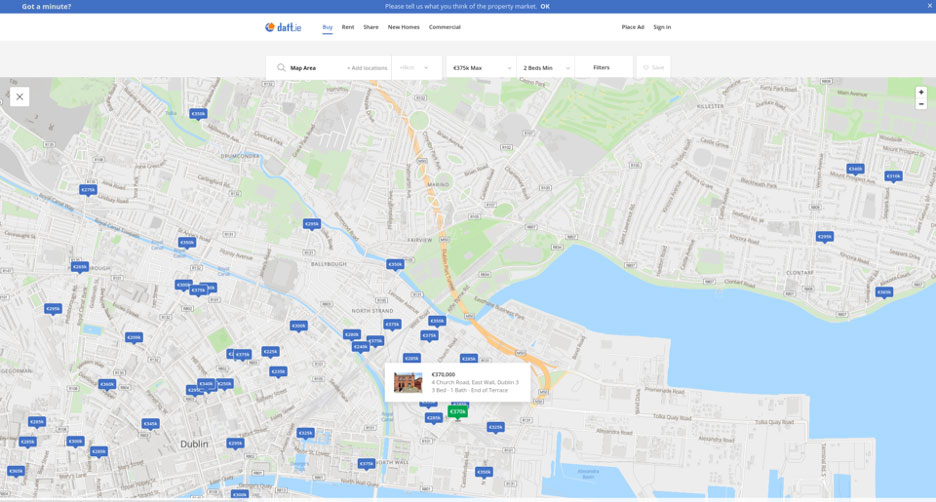
8. Follow the link to the property to arrive to the property page & take a virtual tour!

9. Further down the page you will details like those outlined below:
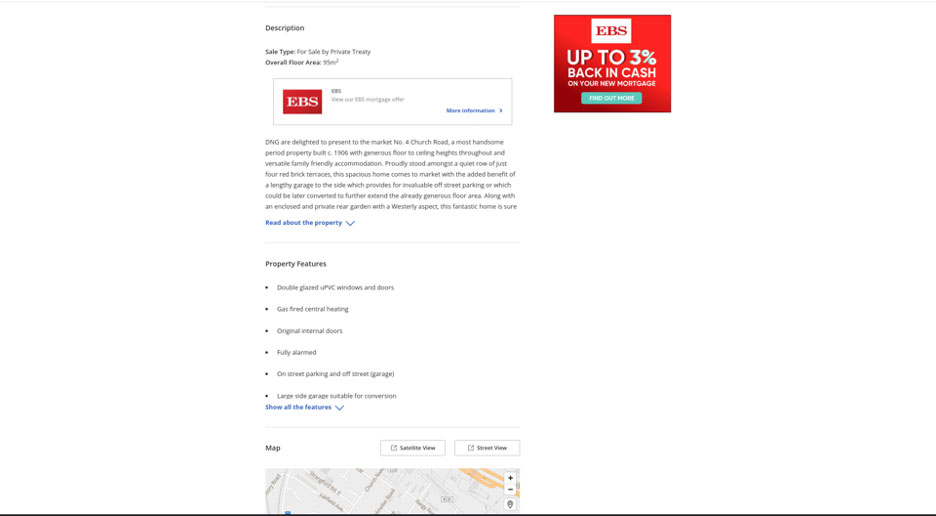
10. You can check details like the energy rating in the house and use a Mortgage calculator provided on the bottom of each of these pages:
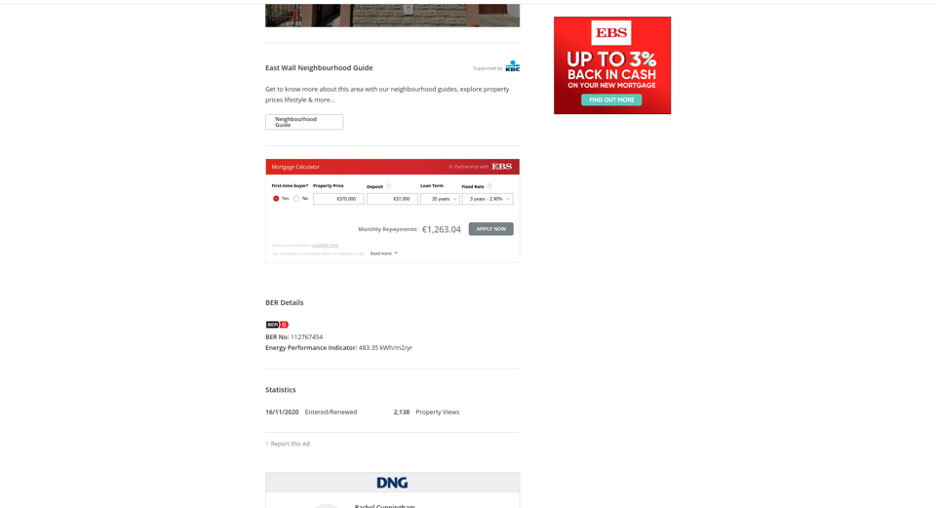
11. On each Property Page you will have the option of Contacting the Landlord or relevant Estate Agency
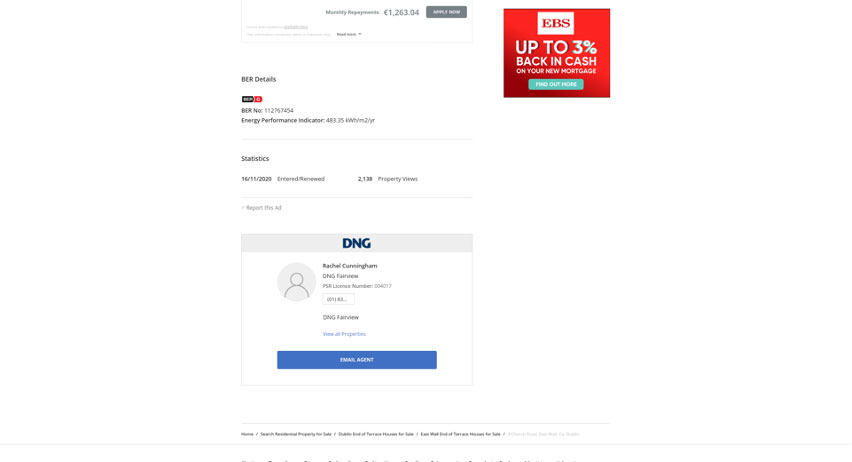
Work with an Estate Agency
Here’s a list of the best:
Sherry Fitzgerald
You can search for your preferred property type, number of rooms, price and more! Alternatively, chat with an agent to get assistance on your search.
Savills Estate Agency
Hooke and McDonald
McNally Handy
*Note: will likely find these properties listed on daft.ie as many Estate Agencies use this function, you can check the agency on daft, see screenshot below:
Tips and Helpful Resources from Citizens Information
1. Costs Associated with Buying a Home
2. Steps to Taking out a Mortgage
3. Search for a Solicitor Here
4. List of Licensed Property Service Providers in Ireland
5. National Price Register
6. Mortgage Calculator – via Competition and Consumer Protection Commission
7. Citizen’s Information on How to Take out a Mortgage
6. GAS, ESB, Refuse Providers
Once we choose our accommodation, we then find out more about the associated bills.
See this list for typical Bills:
• Electricity (Every Property)
• Heating – Oil, Gas or Electrical
• Wifi (Every Property)
• Refuse – Bins & Waste Disposal – come with some estates, others need to independently set up by tenants/homeowners.
Electricity
This is a bill paid in every property. Some properties include this bill in the monthly cost – if this is the case – it will be outlined on the property description.
Electricity bills arrive once every two months. Usually your provider will estimate your usage based on historical bills, however, you can always send in a meter reading for a more accurate reading. Compare Electrical Providers here.
Electricity Providers in Ireland:
• SSE Airtricity
• Bord Gais
• Electric Ireland
• Energia
• PrePay Power – not billed bimonthly – clue is in the name!
Heating
Heating in Ireland is highly necessary, as such there are a number of different ways to heat your home and associated providers, see below:
Gas or Electric Heating:
Gas and electric heating (often called Dual Fuel) work in the same way, ie, off a meter based on your usage. Generally, Electricity providers also provide Gas and can centralize your bill if you have both electricity and gas in your home. These bills would concurrently arrive once every two months and can be compared over providers here.
See top providers below:
• SSE Airtricity
• Bord Gais
• Electric Ireland
• Energia
Oil Heating
Oil heating generally means there’s a tank by your house (usually in the back garden) that is the fuel for you heating. Here are a list of Oil Providers who will deliver the oil and fill your tank.
• Check oil prices
• Compare oil prices
Oil Providers in Dublin:
• Campus Oil
• Emo Oil
• Air Side Oil
• Liffey Oil
Top Tip: watch the volume of oil in your tank to avoid airlocks!
Refuse
Refuse is sometimes included in rent prices, usually if you live in an estate with a shared bin service. If you are not sure about your arrangement, clarify with you Estate Agency or Landlord. Usually if you move into a rented property, there will be a preexisting Refuse set-up. These bills are usually monthly, allowances differ from provider to provider, see below for a list of these providers:
Refuse Providers in Dublin:
• Greyhound
(you can also get an app for this on Android or iOS)
• The City Bin Company
• Panda Waste
Top Tips – See image Below on Accurate Contents & Best Practice on Recycling:

7. WiFi Providers & Networks
Wifi is pretty easy to set up in Dublin as the city has great coverage. Wifi generally is at the discretion of the tenants to choose and set up. Usually you order a modem from a provider, set it up yourself and connect as per received instructions. These bills are monthly and can be compared over providers here
Wifi Providers in Dublin:
• Virgin Media
• Sky
• 3 Mobile
• Vodafone
• Eir
• Magnet
Top Tip: if you are moving into a property, check the previous tenants Wifi Provider for a seamless transition of accounts!
8. Proof of Address
What is Proof of Address?
Here in Dublin, whether you’re opening up a Bank Account or signing up with Revenue for your Taxation in Ireland, you will be required to have “Proof of Address”. This is a document that contains information about where you live as a form of proving your identity in addition to a passport or some other Legal form of Identification.
The Document must contain the address of the property in which you live, as well as when you started to live there. For more information visit citizensinformation.ie
When do I need Proof of Address?
You will likely need you Proof of Address in any of the following circumstances:
• Opening a Bank Account
• Getting your PPS Number
• Setting up WiFi for your house or Apartment
• Setting up Electricity account for your House or Apartment
• Setting up your phone with an Irish Phone number
What does proof of address look like?
Proof of Address can be gotten in any of the following forms:
• A Letter from Your Landlord or Estate Agency Stating your name and Move In Date
• A Utility Bill in your name (Electricity Bill, Gas Bill, Phone Bill)
• A Letter provided by a Governmental Body confirming your address
• A Social Insurance Document
*For a full list of possibilities visit citizensinformation.ie
Join us and thrive
Your next opportunity starts here. Whether you're actively searching or simply exploring what’s next. our Talent Community connects you with opportunities that align with your goals.
